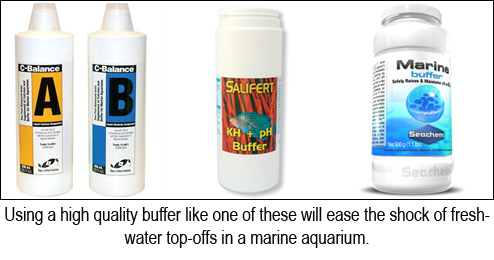Tips From The Pros: Buffering your RO/DI Top-Off Water

In writing this article, the assumption is that most aquarists are now using RO or RO/DI water when doing freshwater top-offs in their marine tanks. I hope this is true, because anything less is really inferior. RO/DI water is the purest water you can add, and it is the only way to ensure that contaminants do not enter your system via freshwater. If you are not using it, I will give you four brief reasons why you should: chlorine, chloramines, phosphates, and copper. Any or all of those four chemicals, plus more, are in the tap water that enters our homes. Though not particularly harmful to us in small doses, none of them are acceptable additives to a marine system (copper medications notwithstanding).
If you are not familiar with the RO/DI process, it is easily explained. RO, which stands for Reverse Osmosis, is the process by which water is forced through a membrane with tiny holes. The holes only allow the smallest of molecules to pass (water is a very small molecule). RO is a great way to remove particulate matter and large molecules like chloramines. DI, or De-Ionization, uses chemically active resin beads which, when exposed to water, exchange dissolved ions for hydrogen ions embedded on the beads surface. The method strips unwanted ions from the water, leaving only pure constituents of water left over.
While we desire the pure water, it is in fact, too pure! Yes, I said ittoo pure! Pure water has a pH of around 7.00. Though considered neutral, a more proper explanation is that pure water is actually acidic and basic at the same time. That is, it has properties which lie on either end of the acid/base spectrum, depending on the pH of that with which it reacts. For marine aquarists, this is significant because our tanks are basic (pH 8.1 to 8.4). Pure water acts as an acid in seawater by using up whatever buffers are present (chemicals that negate the effects of acids and bases) and depressing the pH. In this manner, alkalinity, or the relative buffering capacity of the water, is reduced. To be sure, the depression happens slowly, but on a long-term basis the alkalinity will drop. To combat this process, simply add a good buffer to your RO/DI water after you make it. Doing so will ease the shock of freshwater input by bringing the chemistry of the top-off and tank waters closer together.
There are a number of products available, made by reputable companies such as E.S.V, Kent Marine, Salifert, Two Little Fishies, and SeaChem. Some aquarists have even used baking soda, which is simply the buffer sodium bicarbonate. I would not recommend using baking soda because the purity is suspect, and the dosing may be unreliable. Nonetheless, the use of an appropriate buffering additive is highly advisable. Everything we can do to ensure the survival of our marine livestock is worth doing, and this is a simple way to gain control of yet another important husbandry factor. Stable pH and alkalinity levels are keys to ensuring the long-term health of our valuable marine pets.
